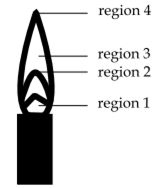 Long Answer Type
Long Answer TypeGive a brief description of the principles of the following techniques taking an example in each case.
(a) Crystallisation (b) Distillation
(c) Chromatography
Discuss the principle of estimation of halogens, sulphur and phosphorus present in an organic compound.
Why is nitric acid added to sodium extract before adding silver nitrate for testing halogens?
In the test of halogens from sodium extract, a small amount of dilute HNO3 is added. This is because in testing the halogen from the Lassigne's extract, it contains halogens. IN case nitrogen and sulphur are also present along with halogens in the organic compound, then along with sodium halide compound, we also get sodium sulphide and sodium cyanide.
Nitric acid decomposes sodium cyanide and sodium halide. else, they precipitate in test and misguide the result.
NaCN +HNO3 -> NaNO3 +HCl
Na2S +2HNO3 ->2NaNO3 + H2S
Therefore, dilute nitric acid is added before testing halogens to expel all the gases if evolved.
 Short Answer Type
Short Answer TypeIn the organic compound CH2 = CH – CH2 – CH2 – C ≡ CH, the pair of hybridised
orbitals involved in the formation of: C2 – C3 bond is:
(a) sp – sp2
(b) sp – sp3
(c) sp2 – sp3
(d) sp3 – sp3
 Multiple Choice Questions
Multiple Choice QuestionsPresence of nitrogen in which among the following compounds can not be detected by Lassaigne method?
Hydrazine
Aniline
p-toluidine
Picric acid
The hottest region of Bunsen flame shown in the figure below is:
region 2
region 3
region 4
region 4
The distillation technique most suited for separating glycerol from spent-lye in the soap industry is:
fractional distillation
steam distillation
distillation under reduced pressure
distillation under reduced pressure
Which branched chain isomer of the hydrocarbon with molecular mass 72u gives only one isomer of mono substituted alkyl halide?
Tertiary butyl chloride
Neopentane
Isohexane
Isohexane
Identify the compound that exhibits tautomerism
2-Butene
Lactic acid
2-Pentanone
2-Pentanone
